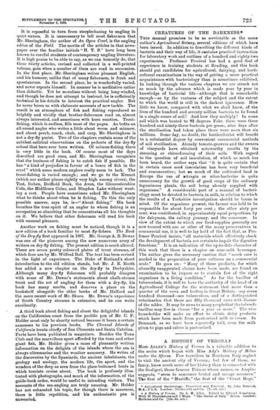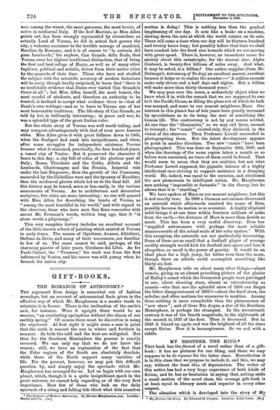A. HISTORY OF VERONA.t
MISS ALLEN'S History of Verona is a valuable addition to the series which began with Miss Ady's History of Milan under the Sforza. Few travellers in Northern Italy neglect to visit the ancient city of Verona ; but few of these, we fancy, know much more of her Mato! y than is connected wii h the Scaligeri, those famous Princes whose names, as Ampime suggests, "seem to announce brutal and savage manners." The first of the "Mastiffs," the first of the "Great Doge,"
• Agricultural Bacteriology : Theoretical and Practical. By John Percival, F.L.S. London: Duckworth and Co. Ps. 61. net.] t A History of Verona. By A. Id. Allen. Edited by Edward Armstrong. With 20 Illustrations and 3 Naps. "The States of Italy" Series. London: Methuen and Co. [Us. 61. net. I
were among the wisest, the most generous, the most heroic, of rulers in mediaeval Italy. If the first If astino, as Miss Allen points out, has been wrongly represented by chroniclers as actually Lord of Verona, he did in actual fact govern the city, a welcome successor to the terrible scourge of mankind, Ezzelino da Romano; and it is of course to " la cortesia del gran Lombardo," his nephew, Can Grande della Scala, that Verona owes her highest traditional distinction, that of being the first and best refuge of Dante, as well as of many other fugitives, political and artistic, driven from their native cities by the quarrels of their time. Those who have not studied the subject with the scientific accuracy of modern historians will be sorry, though hardly surprised, to learn that "there is no irrefutable evidence that Dante ever visited Can Grande's Court at all"; but Miss Allen herself, the most honest, the most careful of students, and therefore an authority to be trusted, is inclined to accept what evidence there is—that of Dante's own writings—and so to leave to Verona one of her most honourable traditions. The life-story of Can Grande, as told by her, is brilliantly interesting; in peace and war, he was a splendid type of the great Italian ruler.
But the whole story of Verona was well worth telling, and may compare advantageously with that of even more famous cities. Miss Allen gives it with great fullness down to 1405, when the Scaligeri had sunk into insignificance, and when, after some struggles for independent existence, Verona became what it remained, practically, for four hundred years, a vassal city of Venice. But it preserved the character it bears to this day: a city full of relics of the glorious past of Italy; Rome, Theodmic and the Goths, Alboin and the Lombards, Charlemagne and the Franks, Imperial rule under the last Emperors; then the growth of the Commune, succeeded by the Ghibelline wars and the tyranny of Ezzelino; then the mediaeval glories which led on to the final falL All this history may be traced, more or less easily, in the various monuments of Verona. As to architecture and decorative sculpture, few cities are more interesting : no one will quarrel with Miss Allen for describing the tombs of Verona as "among the most beautiful in the world," and with regard to the churches, those who have seen San Zeno remember with assent Mr. Freeman's words, written long ago, that it "is alone worth a pilgrimage."
This very complete history includes an excellent account of the little-known school of painting which existed at Verona in early times. The names of Ognibene, Avanzo, Altichieri, Stefano da Zevio, and many of their successors, are familiar to few of us. The same cannot be said, perhaps, of the charming painter of later years, Girolamo dai Libri. As for Paolo Caliari, the "Veronese," his work was from the first influenced by Venice, and his career was still young when he forsook his native city.



































































 Previous page
Previous page